As I write this, I’m looking out my window and watching the farm turn white. We’ve really only had one other snowfall this winter that produced any accumulation and that only lasted for a couple of hours. This one will likely last longer, but I don’t expect it to get too bad. I have lots of friends and family in other areas who have been reporting significantly more snow and worse conditions. As long as we don’t get an ice storm later in the week, I’ll be happy. Below are a few of my nature-related discoveries and observations over the last few weeks.
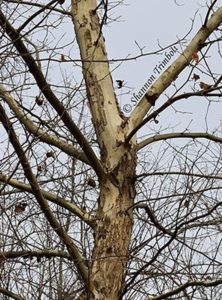
Being able to identify a tree by its bark is a really good skill to have, because leaves aren’t always present on many trees or the leaves may be too high up to get a good look at them. However, for whatever reason, many of us are drawn to the leaves and learn how to identify them much faster and easier than we learn to identify the bark. I completely get it and am one of those people too. I can identify quite a few trees by their bark, but I’m always much more comfortable with the leaves. My husband, on the other hand, is one of those who is really good with the bark, as well as the leaves, so everyone is different.
Anyway, for those of us who maybe struggle a little more with identifying trees without their bark, winter can be a great time to try and improve on our skills. Without lots of green leaves to distract us, it’s much easier to pay attention to the bark and other characteristics of the trees. Two trees that I think are pretty easy to start with are the American sycamore (Platanus occidentalis) and the American beech (Fagus grandifolia).
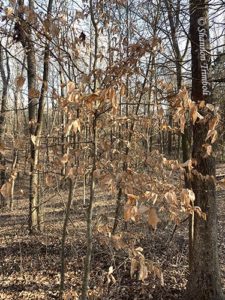
You can often find American sycamores growing in wetter areas throughout the eastern U.S. The outer layers of sycamore bark naturally peel off to expose a beautiful array of whites, creams, browns, and olive greens, especially in the upper parts of the tree. A group of young students I worked with once dubbed this the camouflage tree. I can easily see why they would nickname it that.
Look through the woods during the winter in the eastern U.S. and you might see several trees that still have golden brown leaves hanging onto their branches. There’s a good chance that these are American beech trees. Ok, yes, maybe that’s a bit of a cheat because we’re still using leaves to help us identify the trees, but the presence of the dried leaves is a good initial clue at this time of year.
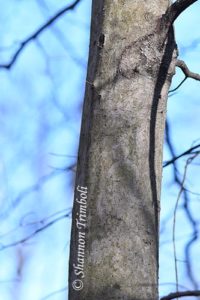
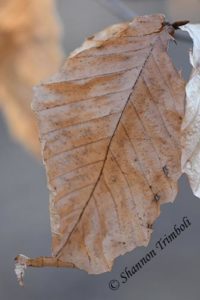
Beech leaves will stay on the trees throughout most of the winter. Younger trees hold onto their leaves longer than older trees, which is why most of the trees you see with lots of leaves at this time of the year are saplings that are often only as tall as 2-3 people standing on each other’s shoulders. Other ways to identify beeches are by their generic leaf-shaped leaf, cigar-shaped buds, and very smooth grey bark. On medium sized beech trees, the smoothness and color of the bark kind of make the trunks look like elephant legs.
If you walk through a stand of goldenrod during the winter, then you are likely to find that some of the stems have formed balls. These balls are often ping-pong to golf ball sized and are called goldenrod galls. Goldenrod galls are formed by the larvae of the goldenrod gall fly (Eurosta solidaginis). In the spring, the goldenrod gall fly lays her eggs on the outside of a goldenrod stem. After hatching, the larvae burrows into the stem. Its saliva causes the plant to create extra tissue that produces the characteristic swollen gall. The larvae will eat the tissue and will spend the winter in the gall before molting into an adult fly and emerging in the spring. During the winter, downy woodpeckers, Carolina wrens, chickadees, and several other songbird species will sometimes peck the galls open to devour the larvae hidden inside. We have a large stand of goldenrod and this year it is covered in goldenrod galls. I cut this goldenrod gall open so you could see the larvae inside.
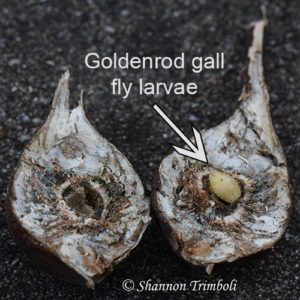
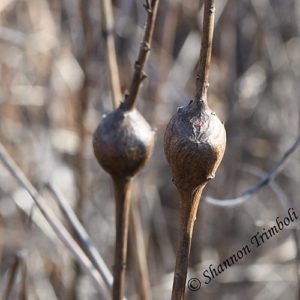
Earlier in January, we woke up to around half an inch or so of snow on the ground. We already have more snow than that with the current storm and we still have flurries. I haven’t had a chance to go outside, yet today, but I did take some time after the January snow to go explore around our farm and see what nature-related discoveries I could make before the snow melted that afternoon.
So, what interesting nature-related discoveries have you made in your yard and community over the last few weeks? I always enjoy hearing what others are finding too.
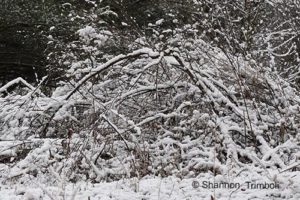
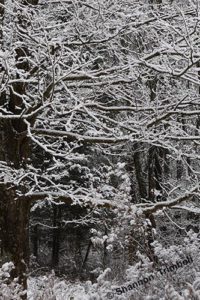
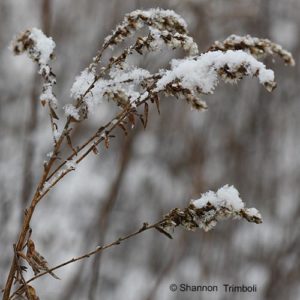
Please tell your friends about Backyard Ecology.
(Social media sharing buttons can be found below the footer.)

Backyard Ecology: Exploring Nature in Your Backyard
Nature isn’t just “out there.” It’s all around us, including right outside our doors. Hi, my name is Shannon Trimboli, and I am the host of Backyard Ecology. I live in southcentral Kentucky and am a wildlife biologist, educator, author, beekeeper, and owner of a nursery specializing in plants for pollinators and wildlife conservation. I invite you to join me as we ignite our curiosity and natural wonder, explore our yards and communities, and improve our local pollinator and wildlife habitat. Learn more or subscribe to my email list at www.backyardecology.net.

Leave a Reply to Backyard Ecology Cancel reply